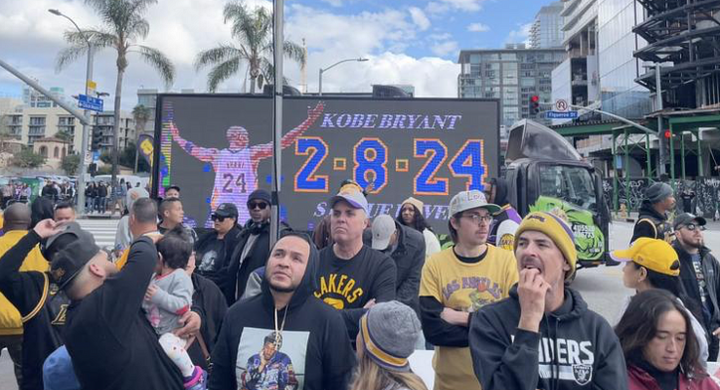KOBE BRYANT STATUE UNVEILING CEREMONY
Crypto.com Arena
Los Angeles
Feb. 8, 2024
I had come for the reveal, true, but was not there to see the veil lifted. I was outside the arena, surrounded by large, crying men. When it comes to professional sports, crowds are typically figured as thunder and worship and yelling. But those gathered on February 8 in downtown Los Angeles to see the new bronze statue of Kobe Bryant were neither violent nor loud. The mood was half-somber, half-confused. We quietly chanted his name and clutched our offerings: framed photographs, flickering votives, rosaries dyed purple and gold.
The ceremony was closed to the public. A tent and barricade had been erected such that the statue would, even upon the unveiling, remain hidden from view. We could see it, said the cops, at 10:00 a.m. on Friday. But we did not leave. We stood at the barricade and watched on our phones as the proceedings began. There were speakers: Kareem Abdul-Jabbar, Phil Jackson, Jeanie Buss. They had known him. Their grief was personal and real. But from the faces in the crowd, I learned that grief doesn’t need a “real” relationship to be sincere, devastating, or meaningful.
What did Kobe mean? Anyone who’s watched sports knows that athletes have distinct narrative meanings and trajectories. The NBA is a power drama of kings and freaks and jokers and magic. But in this schema, Kobe stood apart in that his greatness wasn’t always cast as divine or innate. Kobe was about work, dedication, relentless self-improvement. He was about cold-bloodedness, precision, speed. These qualities — the “mamba mentality” — became a resonant and useful framework for anyone seeking to overcome mediocrity, weakness, or fear. In this way, Kobe was deeply involved in how we relate to our own dreams, and grieving him invited us to reconcile these better, unrealized versions of ourselves with the reality of death.
Perhaps it’s this irreconcilability which has made mourning Kobe such an extravagant and spiritual affair. I am particularly moved by the halfway-religious belief that he continues to influence the world of the living. Consider the evidence. There are instances of coincidence, visual echoes of his movements, his game. There are uncanny appearances of the numbers two, eight, and 24, seemingly fated fulfillments of the motivational challenges he issued to the league’s young stars. But perhaps the most compelling proof of his guidance is the Lakers winning the 2020 NBA Finals after an emotional postseason marked by moments — like Anthony Davis screaming “Kobe” upon releasing a game-winning shot in the final second of game two of the Western Conference Finals — of remembrance and love.
As the unveiling culminated, Vanessa Bryant, Kobe’s widow, spoke, and then the curtain fell. I knew the statue was unveiled because I felt a gentle energy ripple through the City of Angels, and because I watched it on my phone. Everybody cheered, embraced, and slowly dispersed. I walked a few blocks and glanced back. Hundreds of people still stood before the featureless barricade, as if they believed they’d eventually be able to see through it if only they kept looking hard enough.






